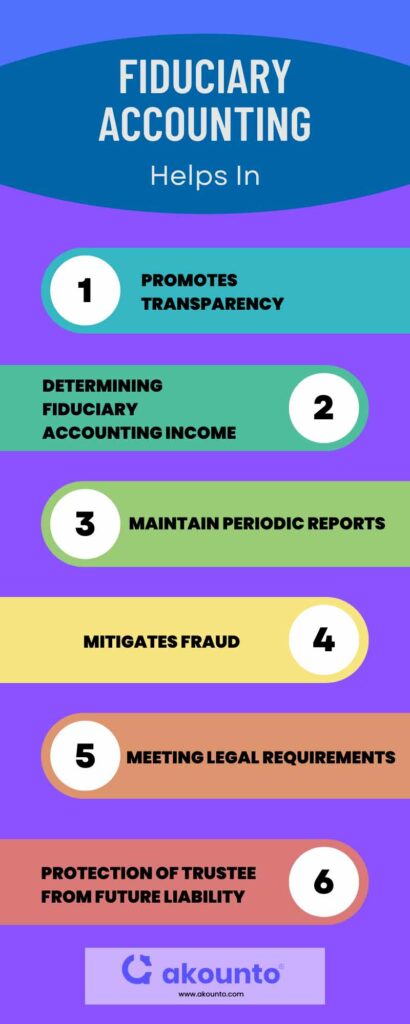What is Fiduciary Accounting?
Fiduciary accounting or court accounting records all financial transactions of an estate, trust, guardianship, or conservatorship, etc., for a specified period and prepares a comprehensive ‘fiduciary accounting report.’
A fiduciary or trustee represents the beneficiary’s interest in a trust or estate and owes many duties to the beneficiary. The breach of duty can result in liabilities, both financial and legal.
The trustee’s administration prepares regular fiduciary trust accounting statements for all the beneficiaries to establish transparency regarding the management of assets, cash, investments, receipts, disbursements, etc., in a trust or estate.
What’s covered in the article
Detailed Explanation
Trust is formed to manage or govern a principal asset or assets held on behalf of the beneficiary.
The current return generated from the principal asset in the form of receipts and disbursements needs to be allocated between the principal and income. This allocation is one of the major responsibilities of the trustee’s accounting work. It helps to determine ‘Fiduciary Accounting Income‘ (FAI).
The trustee has to generate a comprehensive report containing a detailed description and all the supporting documents highlighting that the trustee has been properly allocating income and disbursements per the governing instruments and applicable state law.
One must always check for any fixed format for reporting at the state level, local jurisdiction, or filing requirements at the local county level. The court of law generally accepts the National Standard Format if there are no formats. Many states with some modifications have adopted Uniform Principal and Income Act.

The requirement for fiduciary accounting arises due to:
- Provision by the ‘Governing instrument’ of the estate.
- Required as per the state statute
- Ordered by the court
- Requested by the beneficiary
What is the Importance of Fiduciary Accounting?
Annual or periodic reports aid in the management of the trust. While upholding the beneficiary’s interest, the trustee maintains detailed documentation where the information presented is based on the statute or trust deed.
Maintaining records periodically eases the reconciliation process, and the trustee’s administration can proactively undertake course correction before it’s too late.
The trustee may also protect himself from future liability by mitigating any fraud for the period covered under periodic reporting. This process also generates a documentation trail, and accounts are not lost due to any turnovers, consolidations, or disasters.
Annual tax compliance also mandates accounting and maintenance of records of income, receipts, disbursements, investments, etc. The ready reports are needed by interested parties to clearly define the income and current book value of the principal assets or estate.

Fiduciary Accounting Standards
Fiduciary accounting is different from traditional accounting. Fiduciary accounting classifies between principal and income and also provides detailed descriptions of financial transactions.
It is done on the cash basis of accounting, and any receipts and disbursements are recognized only when the amount is received or paid.
The fiduciary accounting statement is meant to present a report showing that the specific trustee has properly recorded all the transactions and highlights all the material information to the income beneficiary.
There are varied methods of settling the accounts. A formal settlement in light of the governing instrument and state law is done in case of a litigation. A legal settlement is also needed where a trustee wishes to be relieved of his responsibilities.
While in other cases, an informal settlement can be reached where the beneficiary signs a receipt, release, and refunding agreement.
Internal Revenue Service Form 1041 is filed as a tax return by a fiduciary to disclose the income for domestic estate or trusts. The trustee declares the income tax liability along with all transactions; wages paid, income, principal assets, and other nonstandard transactions.
Every financial transaction in a trust must be recorded under the appropriate accounts schedule. There are formal rules for details and itemized descriptions of dividends and interests. The disbursements should not be bound in a category but listed separately.
There are also differences in the calculation of tax liability and income. To calculate income, ‘governing instruments’ are preferred, while the US Tax code is selected for tax.
Fiduciary Accounting Examples
Fiduciaries are not just limited to trusts, estates, or any charitable organizations. Rather fiduciaries can also be appointed in small businesses to manage assets, divisions, branches, franchisees, etc.
Fiduciaries have legal responsibilities and cannot be categorized as advisors. Advice is not binding. But the action of the fiduciary makes them legally liable for their actions. Lawyers, stockbrokers, accountants, bankers, etc., can also be appointed as fiduciaries, and they are entitled by power of attorney to act in the interest of the beneficiaries.
Financial fiduciaries like asset management companies create more confidence than financial advisors. The financial fiduciaries need to submit periodic reports justifying their actions and impact.
Akounto helps meet compliance by maintaining accurate, and reliable accounts based on the data entered and provides hassle-free fiduciary accounting.
It has features to map transactions to vendors and customers, thus recording the data in a detailed manner as mandated by the laws.











